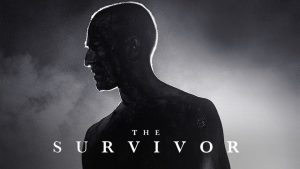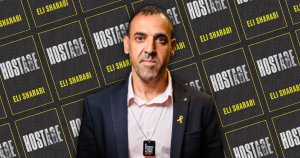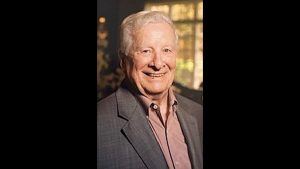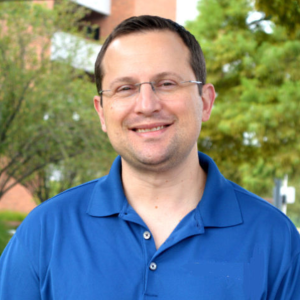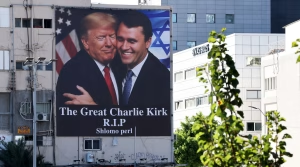How the Holocaust survival story “The Survivor” was made into a movie
Published April 25, 2022
More than 80 years after the end of the Holocaust we are once again living in a time of rising antisemitism, and watching genocide happen, this time in Ukraine. These facts make it even more crucial that we continue to remember and pass down the stories of the past, like that of Harry Haft’s, to new generations. Haft’s story is retold in the new film, “The Survivor,” directed by Barry Levinson and will premiere on HBO on April 27th, Yom Hashoah, Holocaust Remembrance Day.
“The Survivor” | How it happened
A small boy lies awake at night, curious and frightened by the moans and muffled cries emanating from the man fitfully sleeping across the hall. He mumbles in an unfamiliar language and seems to be recalling a horrific experience. Not until many years later does the boy learn the reason for the tormented man’s nightmares…
The boy was director Barry Levinson, and memories of those unsettling two weeks with a traumatized houseguest in the Levinson home came flooding back when he read a draft of the script for “The Survivor.”
ADVERTISEMENT
“In 1948, a man suddenly appeared at our house and my parents set up a cot for him in my room,” Levinson recalls. “Every night he tossed and turned and screamed in horror. It was a seminal experience and it really stayed with me, but in those days, no one talked about things, and I never even knew who he was. One day, when I was about 16, my mother mentioned her uncle Simcha and the fact he was in a concentration camp, and suddenly my memories made a little more sense. I have always been curious about exploring the idea that when someone experiences something like a war or a concentration camp they don’t just leave the experience and get on with their lives.”
After hearing this anecdote, it was clear that Levinson was the obvious choice to direct this tale, according to producer Matti Leshem, the driving force behind bringing Harry Haft’s incredible story to the screen.
“After I read the script, I talked about how an experience like Harry’s colors everything that comes after it,” says Levinson. “I was struck by the idea of being forever haunted. How does it color your relationships with your wife and with your kids? I wanted to explore the struggle of hiding so much about your past so that those you love never know about the things you were exposed to because you want to try and protect them.”
ADVERTISEMENT
“I don’t remember a time when I wasn’t aware of the Holocaust,” says Leshem, explaining his passionate connection to the story of Harry Haft. “My father was twenty when he was kicked out of medical school for being Jewish, right at the beginning of the war. His dreams of being a healer were destroyed, so he joined the resistance in order to save lives in different and more urgent ways as part of the Czech underground. He forged an identity card for himself and then became a skilled forger to provide Jews with new identities. While he forged new identities for his mother and sister, they refused to leave and did not survive the war, something that haunted him until the day he died.”
“Growing up in the shadow of a father who had to turn his back on his mother and his sister and never really said much about it was hard,” Leshem continues. “It led me to search out stories about survivors that had to make difficult choices to try and understand what that might have been like. What I was interested in mostly was how amongst the many crimes perpetrated by the Nazis, the one that seemed worst to me, was, what abject circumstances forced a person to do to survive.”
“When I first read the script for “The Survivor,” I felt as though I was on a collision course with this film,” says Leshem. “I met with the writer, a young Australian, Justine Juel Gilmer. Justine was an amateur boxer and a very professional writer, and she had written a heart-wrenching and moving film. We sat in a mediocre coffee shop on the westside of LA and I told her about my father, grandmother, and aunt and why I had waited my whole life to tell a story like this. She agreed to let me produce her script on the spot. Making this film has been the most rewarding professional experience of my life.”
Producer Aaron L. Gilbert was similarly drawn in by the importance of the project’s subject matter. “I had to be part of making The Survivor,” said Gilbert. “There has never been a more important time to tell this story and others like it. We are bombarded with images that remind us of the hate that exists in the world. Today, with anti-Semitism and systemic racism at an all-time high, Harry Haft’s struggle against the forces of evil is reminiscent of where, if left unchecked, we could end up. The saying about those who do not remember history being condemned to repeat it, is more apparent today than at any time. I’m very proud of this film and all who were part of our journey in making it happen.”
To cast the role of Harry Haft, the filmmakers needed an actor who could play a role that spanned decades and credibly portray an accomplished boxer. Ben Foster’s name came up early, as he had worked with Levinson as a teenager in Liberty Heights. It was immediately clear he was up for the challenge, and during the making of the film his eagerness to plumb every nuance of Haft’s experience was astonishing. According to Levinson, “there was never a time he said ‘ok, that’s good enough’ after a take. He would work certain moments over and over until he felt it was right. We were constantly discussing what Harry might have been thinking during the various scenes. He was always eager to find the surprising emotional moments in every encounter.”
“Working with Barry is always exciting,” says Foster. “He creates an environment that peruses idiosyncratic behavior and language. Many of the scenes evolved into improvisations. I think of him as a great jazz conductor. He has a supernatural instinct, a high bullshit meter and is relentless in finding the truth within the music. We laughed a lot on set. Considering the subject matter that makes the film more textured and lived in. Though the film touches on great difficulties, it’s one that suggests hope. The faith in finding your true love and remembering the past while finding a new kind of peace today.”
In addition to his love of the script and his deep respect for Barry Levinson, Foster had personal reasons for playing the role of Harry Haft. “My nanna escaped the pogroms as a child from the Ukraine and arrived on Ellis Island in the 20’s,” says Foster. “She smuggled her baby brother in a picnic basket. The story goes, if they got caught or were turned away, the whole family would return together, which would have meant a death sentence. I am here because of them. My two young children are now the result of my grandparent’s courage to escape war and find safe harbor in America. The opportunity to investigate this story and this history was life altering. The research was intensive. I read a hundred books on the subject, watched countless hours of Holocaust survivor interviews. I plastered my trailer and home with pictures of Harry, 1940 boxers, and photos of the atrocities of the camps. I wanted to be able to close my eyes and only see the world we were inhabiting.”
To prepare for the physically and emotionally arduous role of Harry Haft, Ben Foster lost over 60 pounds, and then regained all of the weight and more to complete the postwar portion of the story. The strict five-month diet regimen of deprivation followed by high-caloric training was under the supervision of a nutritionist and trainer to, as he describes, “push the limits of this kind of physical transformation.”
“When we first discussed portraying three decades of Harry’ life, particularly his time in the concentration camp, it was suggested digital effects could make me appear emaciated,” Foster says. “I told them, if this was the approach of the film, they had the wrong actor. I knew if I was to take this role on, it was necessary for me to drop the weight for myself. I needed to know how far I could go and still be able to fight. I wanted the experience of hunger to inform the rest of Harry’s life in the film. Most people don’t have a choice to go hungry. I made the choice. When I’m asked if it was hard, I say it was a luxury. “
Three months prior to shooting the boxing scenes, Foster began training with stunt coordinator Clayton Barber. The coaching included a strenuous schedule of calisthenics, sparring, and jumping rope, and Foster found himself adopting the mental state of a boxer. As Barber explains, “It’s much like going through boot camp for a military film, and the first step is to establish a mindset that this is going to be extremely challenging both mentally and physically. You’re going to have to learn not just to deliver a punch, but take one. And another. And another. There’s a psychology to withstanding physical punishment that must be built and strengthened just like the body.”
“By the first day of filming I had lost 62 pounds, matching what was recorded as Harry’s lowest weight in the camps,” says Foster, who credits the film’s producers and the professionals who trained him with his astonishing metamorphosis. “I worked with Clayton Barber, Rob Sale and Jon Snow at Trinity Boxing in NY to learn to fight in the style of the era,” says Foster. “I studied Max Baer closely as a fighter. In the film everything was done practically. There are no stunt doubles, and the punches are full contact. We wanted to make it feel as real as possible.”
The second part of the journey to “become” Harry Haft was developing an authentic accent and learning Harry’s speech patterns. “I worked closely with dialect coach Eric Singer and David Braun, a Yiddish expert, to identify the specific sounds of the rural Polish shtetl where Harry grew up. I listened to tapes of Harry but rather than mimicking him, it was about identifying and grounding the quality of this sound in myself. We then developed the dialect as he aged, becoming more Americanized.”
Singer found Foster a willing and enthusiastic student. “Ben grabbed everything with both hands from the start,” says Singer. “There was no suggestion or direction to explore that he didn’t embrace. We both live in New York which enabled frequent meetings to practice the sounds and cadences. Dialect training involves attention to detail, effort, and time. An accent is more than just a collection of sounds. It’s a mouth shape and a posture and a feel. It takes time for it to settle into an actor’s body and soul and imagination.”
Unsurprisingly, screenwriter Justine Juel Gillmer, like many others involved in the project, had a personal connection to the events of World War II – her maternal grandmother had been active in the Danish underground resistance. Although initially drawn to the project because of its boxing storyline, her interest in Haft’s remarkable journey expanded as she continued to learn about the man. “His story was stunning, unimaginably tragic, and yet heart-wrenchingly inspiring. My goal was to try to wrangle this very complicated life and complex man into a form that would be respectful of his experience and illuminate the spirit of how and why he survived.”
During pre-production, Levinson and director of photography George Steel worked closely to develop the aesthetic and tone of the film. As part of his research, Steel pored over the work of photographers such as Saul Leiter, Helen Levitt, and Ernest Haas for reference.
“I wanted to immerse the audience in Haft’s experience, so I decided the opening at the camp would be in a 1940s’ black and white photojournalistic style with lots of hand-held shots, as if we are just picking up moments that we happen to catch,” says Levinson. “Harry’s memories are jagged and rough, with no true continuity. When the story shifts to New York in 1949, we have more color entering the frames, but within that period style of film noir.”
He continues, “As the story concludes in Florida in the 1960s, the palette is distinctly brighter and warmer, with lots of pastel tones. But even in this sunny environment, the darkness from the past manages to cast a lengthy shadow.”
“Working with Barry is an honor,” says Steel. “He’s very collaborative, and once we settled on the different looks we wanted, I set out to achieve that.” One of the choices they made was to employ wider anamorphic lenses in the scenes set in 1941. “We wanted a grittier, grainier look, somewhat underexposed.”
They also decided to mismatch some of the footage in the final grading “to reveal that this is not a concise history but rather the traumatized, disjointed and sometimes abstract recollections of a man on a journey from survival to recovery,” adds Steel.
Principal photography began in Budapest, Hungary before shifting to New York and Savannah, Georgia.
“Shooting in Central Europe not only provides the visual aspects and the faces of the people from the region we are concerned with, but it also lends some emotional significance in being aware that this is the corner of the world where these events took place and where their history is still felt,” says Levinson.
The first day of principal photography took place at Budapest’s Fot Studios. The backlot was transformed into a grim, hazy reproduction of 1943 Auschwitz in the Birkenau forest to shoot the incident which was to permanently scar Harry Haft’s life.
After an intensive period of research, production designer Miljen ‘Kreka’ Kljakovic recreated the infamous work camp Jaworzno where Harry trains and fights. Every detail of the camp was fastidiously constructed, from the real concrete pillars and barbed wire enclosures to the 100-ton slag of coal, which was brought in from Poland.
Producer Jason Sosnoff explains, “Jaworzno was a slave labor camp outside Auschwitz where the stronger and healthier prisoners were sent. Most did not survive. We wanted it to feel authentic so that every actor and extra who stepped foot in the camp felt the weight of the story and the environment.”
When the story shifts to America, costume designer Marina Draghici moved into an entirely new palette, “In 1949 America, there is a strong wave of post-war optimism and the clothes have bold colors and sporty patterns. This is a confident nation ready to prosper and take the reins of the future.” Draghici sourced many of her American costumes from rental houses in London and on the US East Coast, and the European wardrobes from Budapest, Vienna, Madrid, and Berlin.
It took four days and 400 extras in period costumes to create and capture the atmosphere in the Haft vs. Marciano boxing match. Barber and his team Khalid Ghajji and Emmanuel Manzanares designed and choreographed all the boxing sequences. They created “pre-viz” for all of the fights, laying down what Barber calls a “code of action,” which was revised and finalized after getting input from Foster and the filmmakers. With a template firmly established, they were able to modify the movements as needed.
George Steel was as active in the ring as the boxers. Barber calls the synergy between the boxing movements and camera “a beautiful dance,” with Steel as bandleader. “George is a remarkable cameraman and attaches no ego to the work. He goes for the best shots possible and invited us into the process fully.”
Steel utilized ample handheld work in the ring to better capture the action and the anguish, fear, and aggression on Harry’s face. “It’s what motivates me as a cameraman,” says Steel. “When someone gives 150% like Ben, you want to be able to access that. That’s what’s interesting about Ben, is that he goes there emotionally. That’s exciting to film.”
Jamie Kelman, the make-up artist responsible for creating Foster’s facial looks spanning the 1940s to 1960s, says, “Ben does not mind wearing or doing whatever it takes to create a character, so we were able to accomplish some very transformative makeup changes. We used a significant amount of body makeup to illustrate when he was sickly versus when he had health and vitality, and also the swelling, bruises and cumulative changes to the skin after many years of fighting.”
Utilizing prosthetics and varying colors and shades of makeup, the process required up to two hours of preparation. The process was further complicated while shooting in Coney Island and Savannah, Georgia. “Ben is wearing a face full of prosthetics, which is like having plastic wrap on your face, and the very high humidity creates sweat that has nowhere to go and begins to destroy the makeup. It was a constant effort to maintain, but it was well worth the effort.”
Steel is proud of the work he and others have done in support of the cast. “I feel really honored to be part of it, that hopefully we’ve done some interesting work that helps back up their performance.”
Drawing upon a profound childhood memory and an extraordinary story of love and survival, Barry Levinson has created an epic story of strength, courage, trauma, and love in The Survivor. Spanning three decades and two continents, it’s both the story of Harry Haft and that of so many people who are forever colored by the events of their past as they strive to not only to survive, but to live.






